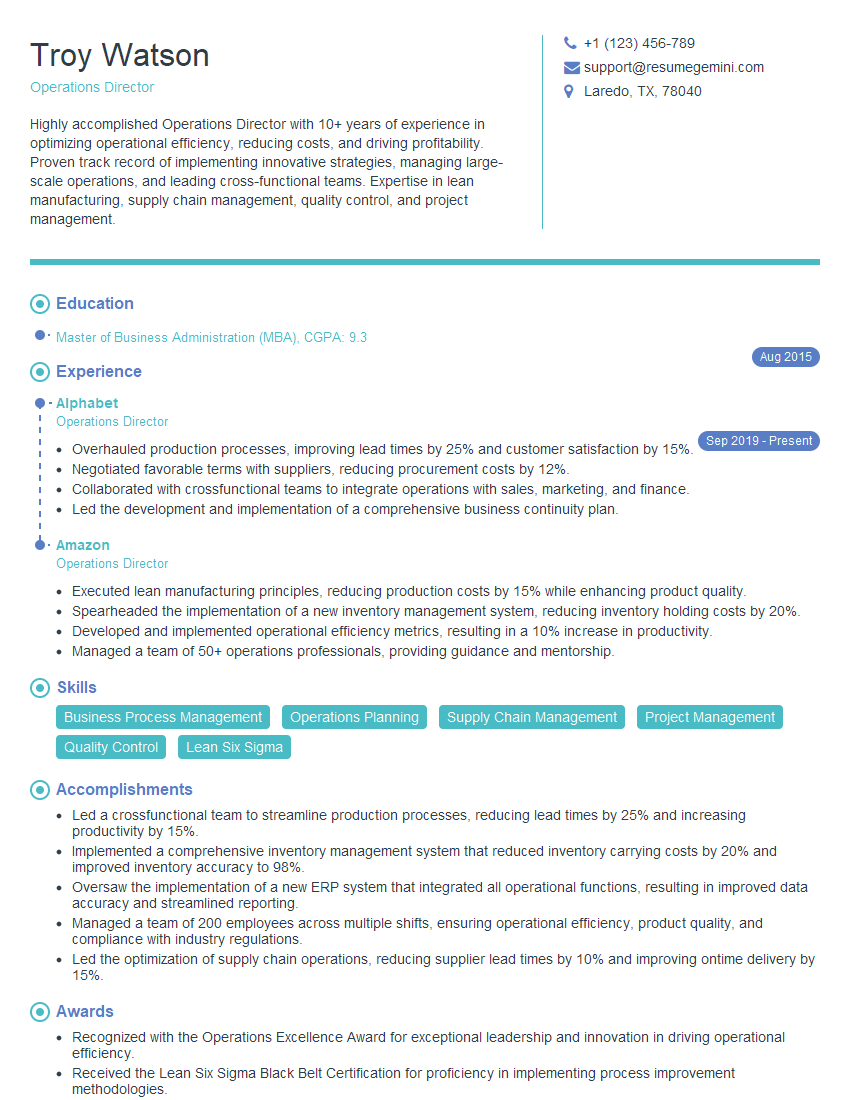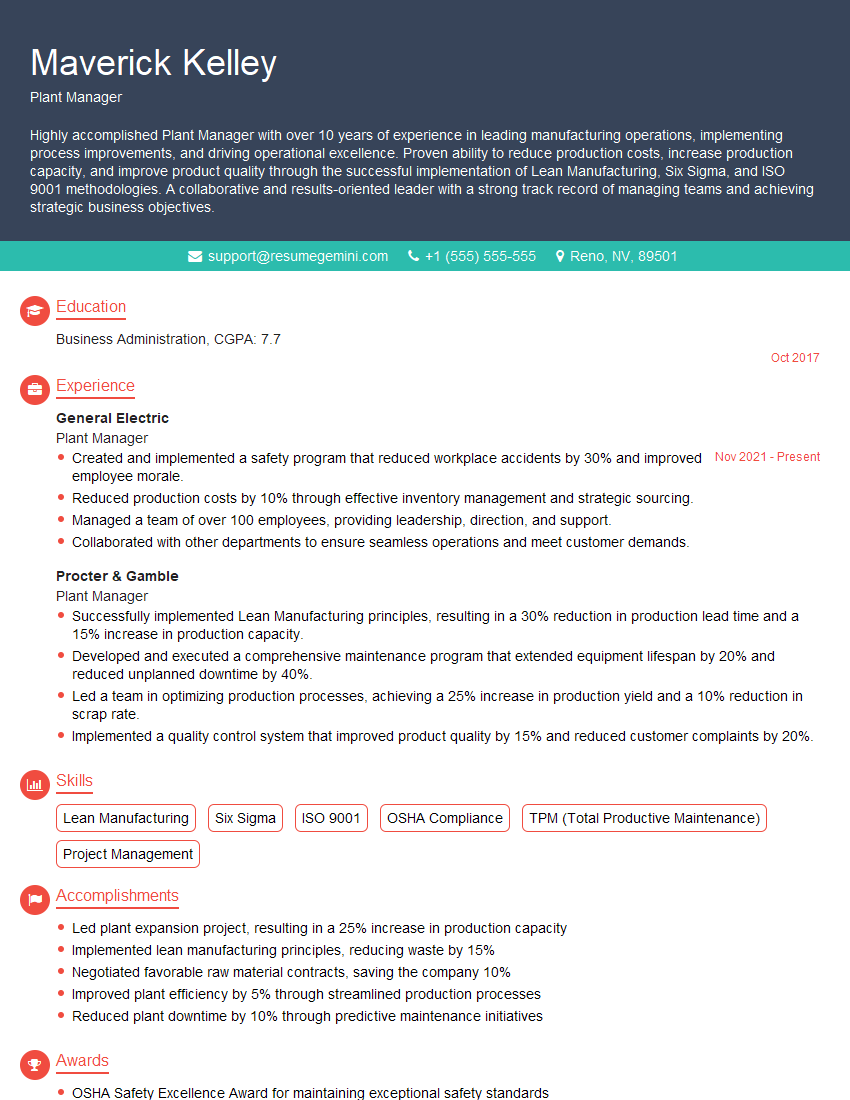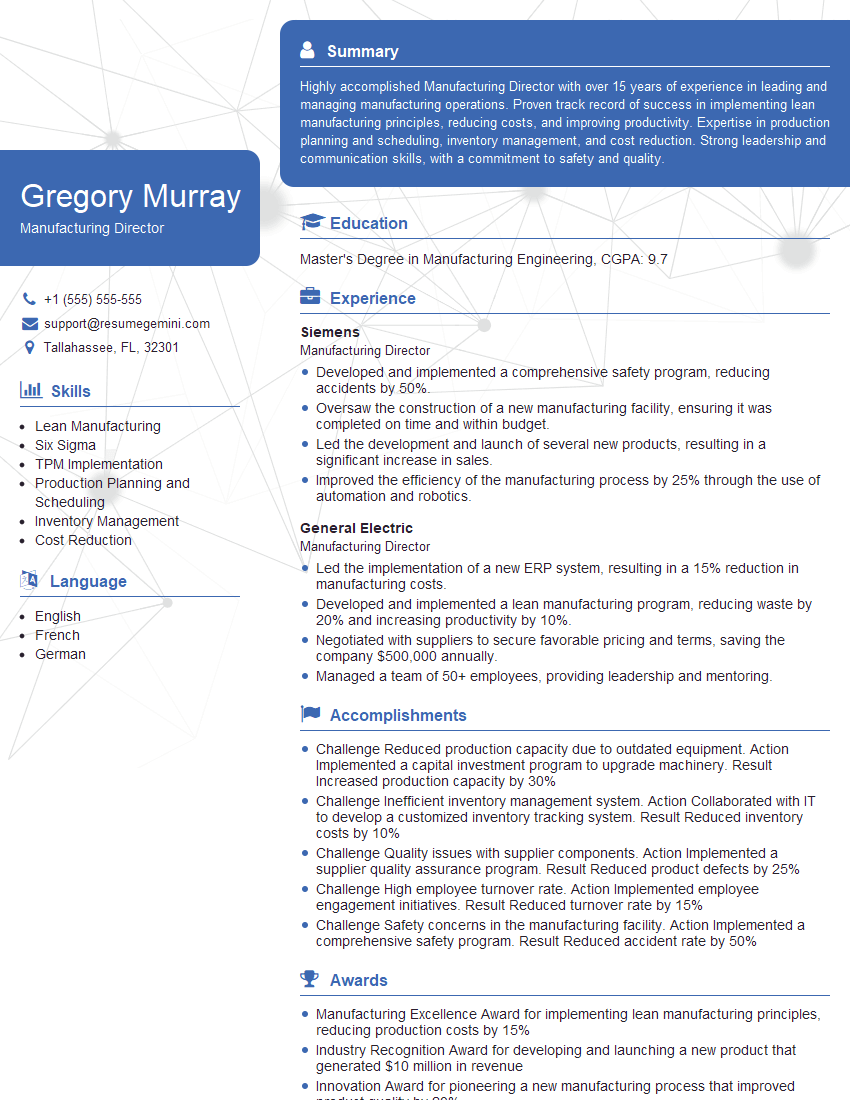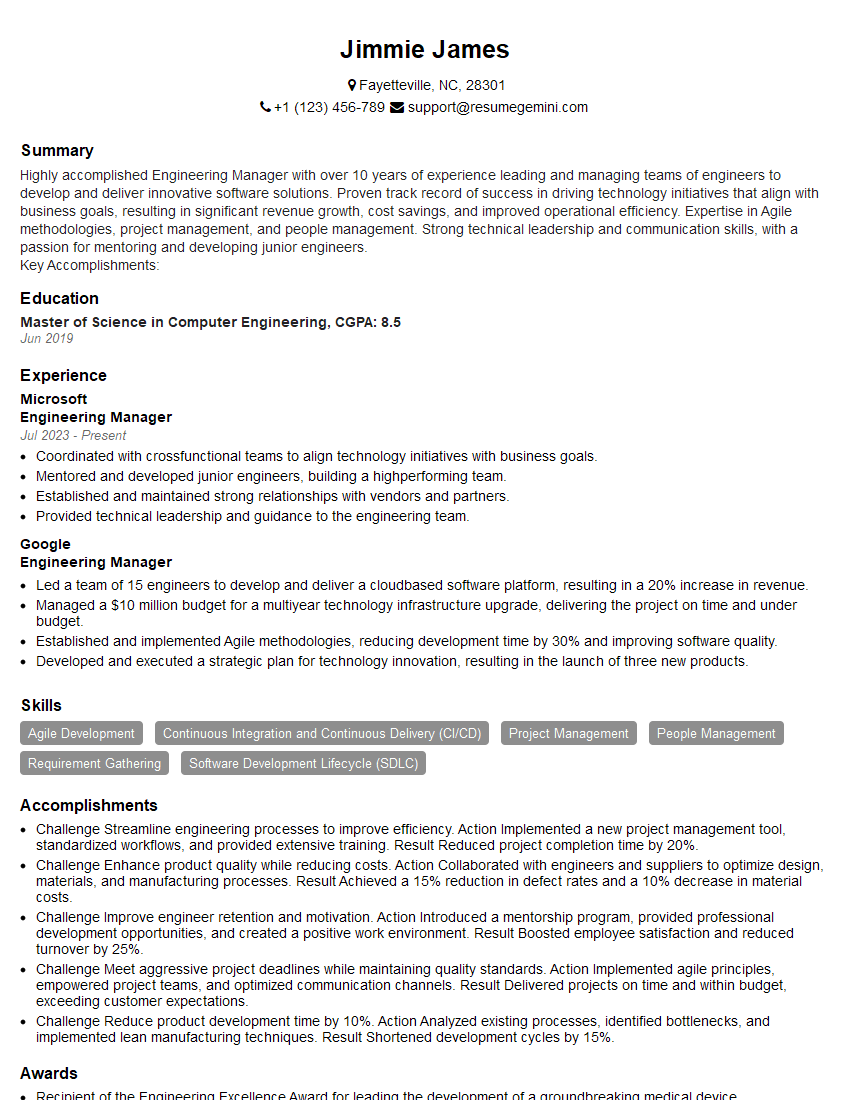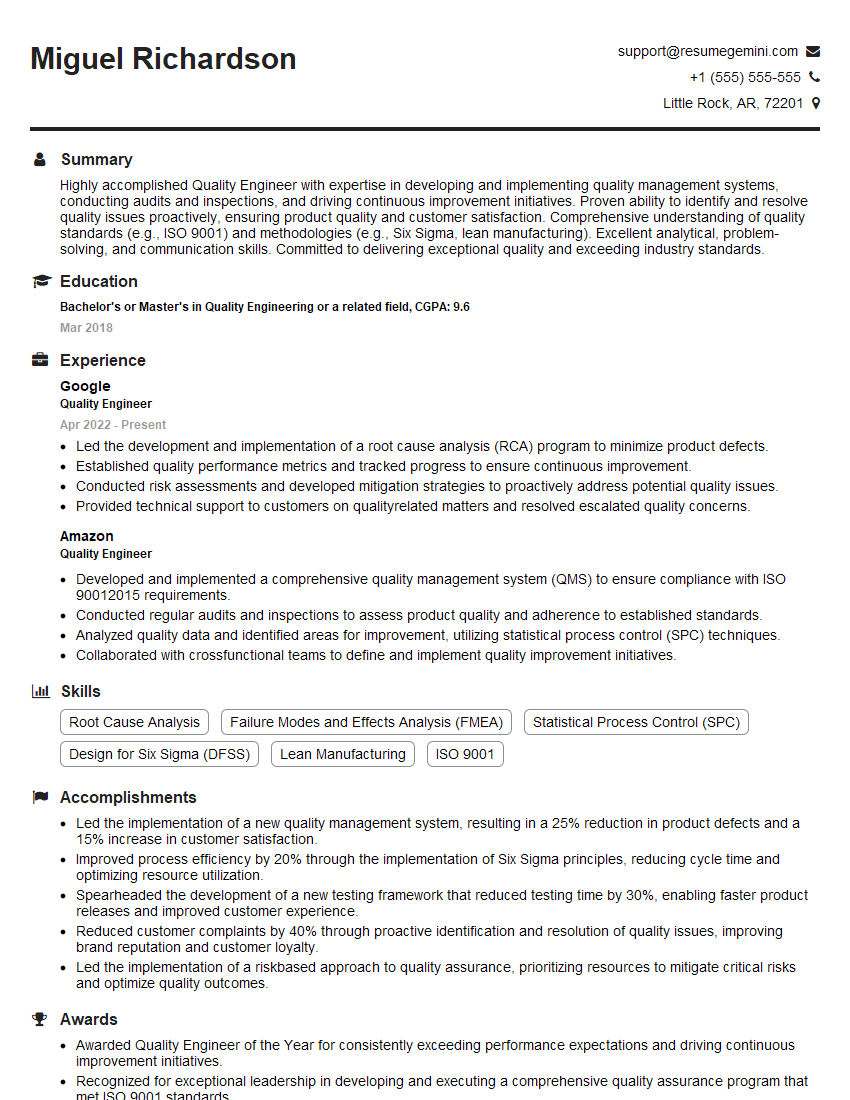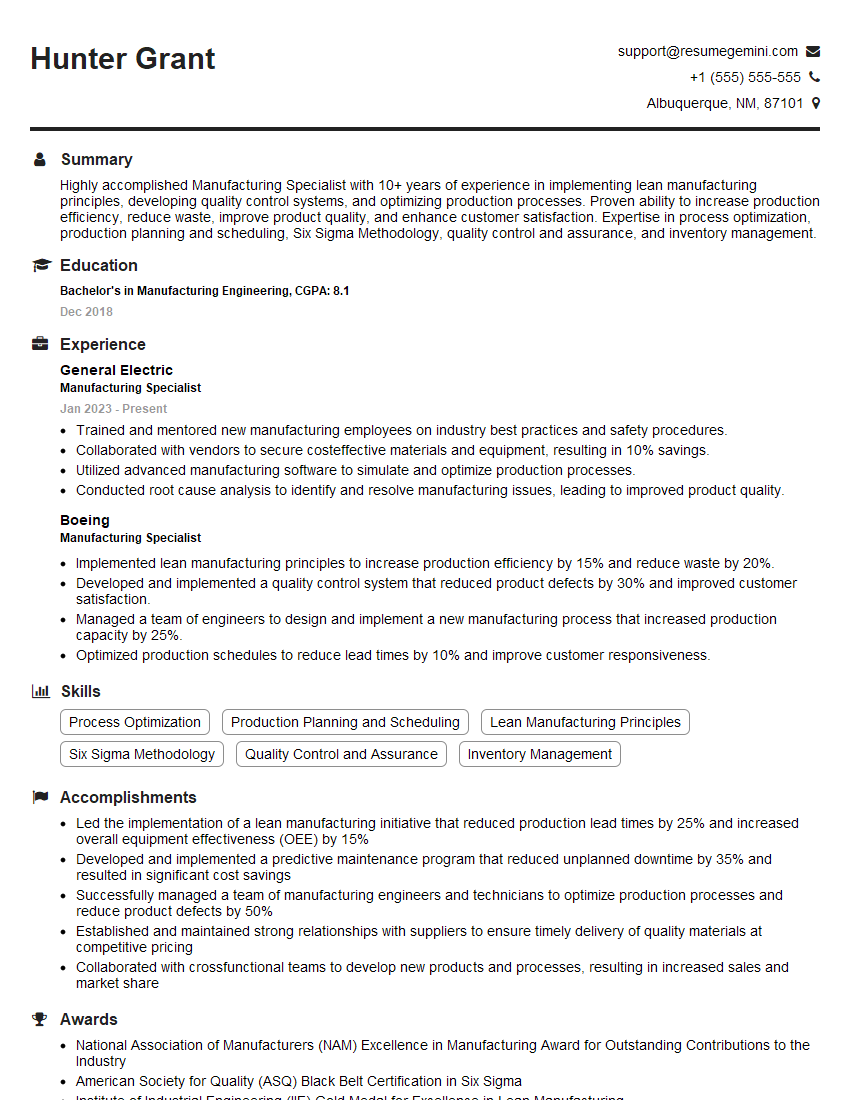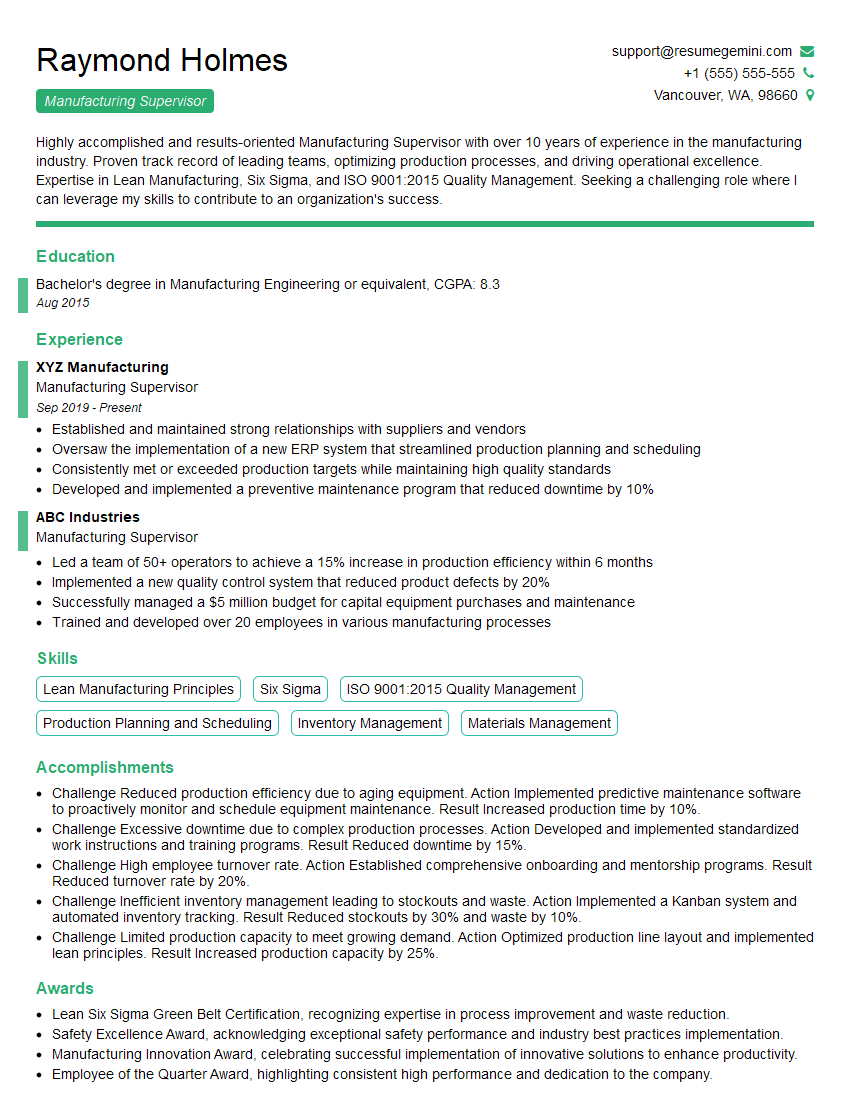Preparation is the key to success in any interview. In this post, we’ll explore crucial In-depth understanding of manufacturing processes interview questions and equip you with strategies to craft impactful answers. Whether you’re a beginner or a pro, these tips will elevate your preparation.
Questions Asked in In-depth understanding of manufacturing processes Interview
Q 1. Explain the difference between Lean Manufacturing and Six Sigma.
Lean Manufacturing and Six Sigma are both methodologies aimed at improving efficiency and quality in manufacturing, but they approach it differently. Lean focuses on eliminating waste (Muda) in all forms – anything that doesn’t add value to the customer. Think of it as streamlining the process to make it faster and more efficient. Six Sigma, on the other hand, focuses on reducing variation and defects in processes. It aims for near-perfection, using statistical methods to identify and eliminate the root causes of defects.
Lean uses tools like Value Stream Mapping (VSM) to visualize the entire process and identify areas for improvement, Kaizen (continuous improvement) for small, incremental changes, and Kanban for managing workflow. Six Sigma utilizes DMAIC (Define, Measure, Analyze, Improve, Control) or DMADV (Define, Measure, Analyze, Design, Verify) methodologies, relying heavily on data analysis and statistical process control (SPC) charts to identify and reduce variation.
Analogy: Imagine baking a cake. Lean would focus on simplifying the recipe, optimizing the baking time, and eliminating unnecessary steps. Six Sigma would focus on ensuring consistent results – every cake is the perfect size, texture, and taste, with minimal variation between batches.
Q 2. Describe your experience with different manufacturing processes (e.g., injection molding, machining, assembly).
My experience spans various manufacturing processes, including injection molding, machining, and assembly. In injection molding, I’ve been involved in optimizing mold designs to reduce cycle times and improve part quality, focusing on process parameters like injection pressure, temperature, and cooling rates. I’ve also worked extensively on troubleshooting defects, such as short shots, sink marks, and warping. In machining, my work has included CNC programming, fixture design, and process optimization to improve surface finish, dimensional accuracy, and reduce tool wear. I’ve also been involved in selecting appropriate cutting tools and machining parameters based on material properties and required tolerances. In assembly, my experience covers process design, line balancing, error-proofing, and implementing automation solutions to improve efficiency and reduce defects.
For example, in a project involving the injection molding of a complex plastic part, I used Design of Experiments (DOE) to identify the optimal processing parameters, resulting in a 15% reduction in cycle time and a significant decrease in the defect rate. In a machining project, I optimized the CNC program and toolpaths, leading to a 10% increase in throughput and improved part quality.
Q 3. How would you improve efficiency in a bottleneck process?
Improving efficiency in a bottleneck process requires a systematic approach. The first step is to identify the bottleneck precisely using data analysis – measuring cycle times, identifying waiting times, and analyzing throughput at each stage of the process. Once the bottleneck is identified, the next step is to analyze its root cause. Is it due to machine limitations, insufficient manpower, material shortages, or process inefficiencies?
Possible solutions include:
- Investing in new equipment or upgrading existing machinery to increase capacity.
- Re-engineering the process to eliminate unnecessary steps or streamline workflow.
- Adding more resources such as personnel or equipment to increase capacity at the bottleneck stage.
- Improving the process through techniques such as SMED (Single Minute Exchange of Die) to reduce setup times, or implementing Kanban to improve material flow.
- Implementing automation to reduce reliance on manual labor and improve consistency.
Q 4. What quality control measures are you familiar with?
I’m familiar with a wide range of quality control measures, including Statistical Process Control (SPC), Acceptance Sampling, Total Quality Management (TQM), and advanced quality planning (APQP). SPC involves using control charts to monitor process variation and identify potential problems before they lead to defects. Acceptance sampling is used to inspect a random sample of products to determine whether a batch meets quality standards. TQM and APQP represent a more proactive approach. TQM emphasizes continuous improvement and focuses on meeting or exceeding customer expectations. APQP ensures quality is designed into the product from the start.
Specific tools include: Control charts (e.g., X-bar and R charts, p-charts, c-charts), Pareto charts (to identify the vital few causes of defects), FMEA (Failure Mode and Effects Analysis), and check sheets for data collection.
Q 5. Explain your understanding of Total Quality Management (TQM).
Total Quality Management (TQM) is a holistic management approach that focuses on continuous improvement in all aspects of an organization. It’s not just about quality control; it’s about embedding a culture of quality throughout the entire organization. Key principles of TQM include customer focus, continuous improvement, employee empowerment, and process management.
TQM involves active participation from all employees at all levels of the organization. It relies on data-driven decision-making, using quality metrics to track progress and identify areas for improvement. Examples of TQM implementation include establishing quality circles, implementing regular process audits, and using tools like Kaizen for continuous improvement.
Q 6. How do you handle production delays or unexpected downtime?
Handling production delays or unexpected downtime requires a swift and organized response. My approach begins with immediately identifying the root cause of the delay – is it a machine malfunction, material shortage, or a process issue? Once the cause is identified, I’ll work to mitigate the immediate impact. This may involve reassigning resources, expediting materials, or implementing temporary workarounds.
In parallel, I initiate a thorough root cause analysis to prevent future occurrences. This often involves involving cross-functional teams to identify systemic issues contributing to the downtime. Effective communication with all stakeholders, including customers, is crucial throughout this process. Once the issue is resolved, a post-mortem analysis is performed to document lessons learned and implement corrective actions.
Q 7. Describe your experience with root cause analysis.
Root cause analysis (RCA) is a systematic approach to identifying the underlying causes of problems. I’m experienced in several RCA methodologies, including the 5 Whys, Fishbone diagrams (Ishikawa diagrams), and Fault Tree Analysis. The 5 Whys is a simple, iterative technique where you repeatedly ask ‘why’ to drill down to the root cause. Fishbone diagrams provide a visual representation of potential causes, categorized by different factors (e.g., people, materials, methods, machines). Fault tree analysis is a more formal method used for complex systems, mapping out potential failure scenarios.
For example, if a machine is repeatedly malfunctioning, using the 5 Whys might lead to uncovering a faulty component, requiring a change of supplier or a preventative maintenance schedule. A Fishbone diagram could help identify potential causes ranging from operator error to improper maintenance to a design flaw.
Q 8. What are your preferred methods for capacity planning?
Capacity planning is the process of determining the optimal production capacity to meet future demand while minimizing costs. My preferred methods involve a multi-pronged approach, combining several techniques depending on the specific circumstances and data available.
Demand Forecasting: I leverage various forecasting techniques, including time series analysis, moving averages, and exponential smoothing, to predict future demand. For example, I might use historical sales data and market trends to project demand for the next quarter or year.
Capacity Analysis: I analyze existing capacity by evaluating equipment utilization rates, labor availability, and facility limitations. This often involves creating capacity models, possibly using simulation software, to understand bottlenecks and potential improvements.
Scenario Planning: I develop multiple scenarios to accommodate various levels of demand, considering factors like seasonality, economic conditions, and potential disruptions. This allows for flexibility and preparedness.
Resource Allocation: Once capacity needs are determined, I optimize resource allocation—labor, equipment, materials—to maximize efficiency and minimize waste. This could involve cross-training employees or investing in new machinery.
Capacity Expansion Strategies: If capacity gaps are identified, I evaluate different expansion options, such as overtime, hiring additional staff, investing in new technology, or outsourcing some production.
For instance, in a previous role, we used a combination of time series forecasting and scenario planning to predict demand for a new product line. By proactively increasing capacity, we avoided production delays and met the strong market demand effectively.
Q 9. How do you ensure compliance with safety regulations in a manufacturing environment?
Ensuring compliance with safety regulations is paramount in manufacturing. My approach is multifaceted and proactive, focusing on prevention and continuous improvement.
Risk Assessment: I conduct thorough risk assessments using methodologies like HAZOP (Hazard and Operability Study) to identify potential hazards and evaluate their risks. This helps prioritize safety interventions.
Implementing Safety Procedures: Based on the risk assessment, clear and concise safety procedures (SOPs) are developed and implemented. These procedures are communicated effectively to all employees through training and regular reinforcement.
Employee Training: Regular and comprehensive safety training is crucial. This includes emergency response training, safe operating procedures, and the use of personal protective equipment (PPE).
Regular Inspections and Audits: I conduct regular inspections of the facility and equipment to identify potential hazards and ensure compliance with regulations. Audits help ensure adherence to safety protocols.
Incident Reporting and Investigation: A robust system for reporting and investigating safety incidents is essential. Investigations aim to identify root causes and prevent recurrence.
Compliance with Regulations: Staying updated on relevant safety regulations, such as OSHA (Occupational Safety and Health Administration) standards, is crucial. This includes understanding and adapting to evolving regulations.
In a previous project, a thorough risk assessment led to the identification of a potential pinch point in a conveyor belt system. By modifying the system design and implementing additional safety guards, we significantly reduced the risk of workplace accidents.
Q 10. Explain your understanding of supply chain management.
Supply chain management encompasses the planning, execution, and control of all processes involved in getting a product from its origin to the end consumer. It’s about optimizing the flow of goods, information, and finances across the entire network.
Sourcing: Selecting reliable suppliers and negotiating favorable terms are critical. This involves considering factors like quality, cost, delivery time, and supplier capabilities.
Production: Efficient manufacturing processes are essential. This includes capacity planning, production scheduling, and quality control.
Inventory Management: Balancing inventory levels to meet demand while minimizing storage costs and preventing stockouts requires sophisticated techniques.
Logistics: This involves transportation, warehousing, and handling of goods. Optimizing logistics is key to timely and cost-effective delivery.
Customer Service: Providing excellent customer service is crucial for maintaining customer satisfaction and loyalty. This involves order fulfillment, tracking, and issue resolution.
I’ve successfully implemented improvements in supply chain efficiency by leveraging technology such as ERP systems and implementing lean methodologies, resulting in reduced lead times and improved customer satisfaction. For example, in one instance, optimizing our transportation network through route optimization software led to a 15% reduction in transportation costs.
Q 11. How do you manage inventory effectively?
Effective inventory management is crucial for maintaining a balance between meeting customer demand and minimizing holding costs. My approach combines several key techniques:
Demand Forecasting: Accurate demand forecasts are crucial to anticipate future needs and avoid stockouts or excessive inventory.
Inventory Control Systems: I utilize inventory management systems, often integrated with ERP systems, to track inventory levels, monitor stock movements, and generate alerts for low-stock items.
Inventory Classification: I employ ABC analysis to categorize inventory items based on their value and consumption rate, allowing for focused management of high-value items.
Inventory Optimization Techniques: I utilize various optimization techniques, such as Economic Order Quantity (EOQ) and Just-in-Time (JIT) inventory systems, to determine optimal order quantities and minimize inventory holding costs.
Regular Inventory Reviews: I conduct regular inventory reviews to identify slow-moving items, expired stock, and potential discrepancies.
In one instance, by implementing a JIT system and collaborating closely with our suppliers, we were able to reduce our inventory holding costs by 20% while maintaining excellent customer service levels.
Q 12. What is your experience with ERP systems?
I have extensive experience with various ERP systems, including SAP, Oracle, and Infor. My experience goes beyond basic data entry; I’m proficient in configuring, customizing, and integrating these systems to optimize manufacturing processes.
Process Improvement: I have utilized ERP systems to streamline processes, reducing manual data entry and improving data accuracy. This enhances efficiency and reduces errors.
Data Analysis: ERP systems provide valuable data for analyzing key performance indicators (KPIs) such as production efficiency, inventory levels, and order fulfillment times. I leverage this data to identify areas for improvement.
Integration with other systems: I have successfully integrated ERP systems with other business applications, such as CRM (Customer Relationship Management) and supply chain management systems, creating a holistic view of the business.
System Implementation and Upgrades: I possess experience in the implementation and upgrade of ERP systems, managing projects effectively and ensuring smooth transitions.
For example, I led the implementation of a new SAP ERP system at a previous company, resulting in a 10% improvement in overall operational efficiency.
Q 13. Describe your experience with different scheduling techniques.
I am familiar with a range of scheduling techniques, each with its own strengths and weaknesses. The best choice depends on factors like production complexity, demand variability, and resource availability.
Finite Capacity Scheduling (FCS): FCS considers the finite capacity of resources, providing a realistic schedule that accounts for constraints. It’s ideal for complex manufacturing environments with limited resources.
Infinite Capacity Scheduling (ICS): ICS assumes unlimited capacity and focuses on sequencing jobs to meet deadlines. It’s simpler but less accurate for environments with resource constraints.
Just-in-Time (JIT) Scheduling: JIT scheduling aims to produce goods only when needed, minimizing inventory and maximizing efficiency. It’s highly effective in reducing waste and improving responsiveness to demand.
Critical Path Method (CPM): CPM identifies the longest sequence of tasks in a project, highlighting critical activities that need close monitoring to prevent delays. It’s useful for managing complex projects with multiple dependencies.
Kanban Scheduling: Kanban is a visual system for managing workflow, often used in lean manufacturing. It promotes continuous flow and reduces bottlenecks.
In a prior role, we transitioned from a simple ICS system to an FCS system, significantly improving on-time delivery and reducing production lead times. We also incorporated elements of JIT scheduling to minimize inventory and improve responsiveness to customer orders.
Q 14. How do you measure and improve production yield?
Production yield is a crucial metric reflecting the efficiency of a manufacturing process. Improving yield requires a data-driven approach focusing on identifying and addressing sources of waste and defects.
Data Collection and Analysis: Comprehensive data collection on production output, defects, and downtime is essential. This data is then analyzed to identify trends and patterns.
Root Cause Analysis: Techniques like the 5 Whys or Fishbone diagrams are used to identify the root causes of defects and inefficiencies.
Process Improvement: Once the root causes are identified, implementing corrective actions is crucial. This could involve process optimization, equipment upgrades, or employee training.
Statistical Process Control (SPC): SPC uses statistical methods to monitor and control process variation, preventing defects and ensuring consistent quality.
Continuous Improvement: Yield improvement is an ongoing process. Regularly reviewing metrics and implementing improvements is essential for maintaining high yield levels.
In one project, by implementing SPC and addressing issues identified through root cause analysis, we were able to increase production yield by 12%, resulting in significant cost savings and increased profitability. For example, identifying a faulty machine part through data analysis and replacing it dramatically reduced the rate of defective products.
Q 15. How do you handle material shortages?
Material shortages are a common challenge in manufacturing, but proactive management can mitigate their impact. My approach involves a multi-pronged strategy focusing on forecasting, supplier diversification, and inventory optimization.
Accurate Forecasting: I utilize sophisticated forecasting techniques, incorporating historical data, market trends, and seasonality to predict future demand accurately. This allows for timely procurement and avoids stockouts.
Supplier Diversification: Relying on a single supplier is risky. I build relationships with multiple, reliable suppliers, ensuring a continuous supply even if one faces disruptions. This includes evaluating suppliers based on factors beyond price, such as lead times, quality, and financial stability.
Inventory Optimization: Implementing an inventory management system, such as Just-In-Time (JIT) or Kanban, helps maintain optimal stock levels, reducing storage costs while minimizing shortages. This requires a close understanding of lead times and consumption rates.
Strategic Stockpiling: For critical components with long lead times or volatile market conditions, strategic stockpiling is a crucial safety net. This involves identifying key materials and holding sufficient safety stock to cover potential delays or disruptions.
For example, in a previous role, we successfully navigated a critical shortage of a specialized semiconductor by leveraging a secondary supplier identified during our supplier diversification efforts, minimizing production downtime.
Career Expert Tips:
- Ace those interviews! Prepare effectively by reviewing the Top 50 Most Common Interview Questions on ResumeGemini.
- Navigate your job search with confidence! Explore a wide range of Career Tips on ResumeGemini. Learn about common challenges and recommendations to overcome them.
- Craft the perfect resume! Master the Art of Resume Writing with ResumeGemini’s guide. Showcase your unique qualifications and achievements effectively.
- Don’t miss out on holiday savings! Build your dream resume with ResumeGemini’s ATS optimized templates.
Q 16. What are your experience with implementing automation in manufacturing?
I have extensive experience implementing automation in manufacturing, focusing on improving efficiency, reducing costs, and enhancing product quality. My approach prioritizes a phased implementation, starting with areas offering the highest return on investment.
Needs Assessment: Before implementing any automation, a thorough assessment is necessary to identify the most suitable processes for automation. This includes evaluating existing processes, identifying bottlenecks, and assessing the ROI of different automation technologies.
Technology Selection: The choice of automation technology depends on the specific needs. This could range from simple robotics for material handling to sophisticated AI-powered systems for quality control. I ensure that the chosen technology integrates seamlessly with existing systems.
Training and Change Management: Implementing automation requires adequate training for the workforce to ensure successful adoption. This involves addressing concerns, providing training on new equipment and processes, and emphasizing the benefits of automation.
Data Analytics: Automated systems generate vast amounts of data. I leverage this data to monitor performance, identify areas for improvement, and optimize the automated processes for maximum efficiency.
In one project, we automated a previously manual assembly line, resulting in a 30% increase in production output and a significant reduction in defects. This was achieved through a collaborative effort involving engineers, technicians, and production workers.
Q 17. Describe your experience with Kaizen or other continuous improvement initiatives.
Kaizen, or continuous improvement, is integral to my manufacturing philosophy. I have a proven track record of implementing and leading Kaizen events and other continuous improvement initiatives, fostering a culture of innovation and efficiency within manufacturing teams.
Kaizen Events: I lead focused, short-term improvement projects, often involving cross-functional teams. These events tackle specific problems or inefficiencies, leveraging the collective knowledge and experience of the team. The goal is to quickly identify and implement solutions, leading to immediate improvements.
5S Methodology: I implement the 5S methodology (Sort, Set in Order, Shine, Standardize, Sustain) to create a more organized and efficient work environment. This simple yet effective system reduces waste, improves safety, and enhances workflow.
Lean Principles: I integrate lean manufacturing principles, such as value stream mapping and waste reduction, to optimize processes and eliminate non-value-added activities. This leads to improved efficiency and reduced costs.
Data-Driven Improvement: I rely heavily on data analysis to identify areas for improvement, track progress, and measure the impact of implemented changes. This ensures that improvements are sustainable and deliver measurable results.
For instance, in a previous role, we used Kaizen events to reduce production lead times by 20% by streamlining a complex assembly process.
Q 18. How do you ensure product quality throughout the manufacturing process?
Ensuring product quality is paramount. My approach focuses on a robust quality management system that integrates quality checks throughout the entire manufacturing process, from raw material inspection to final product testing.
Incoming Material Inspection: All raw materials undergo rigorous inspection to ensure they meet specified quality standards. This prevents defective materials from entering the production process.
In-Process Quality Control: Regular quality checks are implemented at various stages of the production process to detect and correct defects early. This is more cost-effective than detecting defects at the end of the line.
Statistical Process Control (SPC): I utilize SPC techniques to monitor and control process variability, identifying and addressing sources of variation before they lead to defects. Control charts and other statistical tools are employed to maintain process stability.
Final Product Testing: The finished products undergo thorough testing to ensure they meet all required specifications and quality standards before shipment. This may include functional testing, performance testing, and visual inspection.
Corrective and Preventive Actions (CAPA): A robust CAPA system is in place to address any identified defects or quality issues. This includes root cause analysis to prevent recurrence.
I am a firm believer in the philosophy of ‘quality by design’, where quality is built into the product from its conception, rather than merely inspected at the end.
Q 19. Explain your understanding of different production layouts (e.g., line flow, U-shaped).
Production layouts significantly impact efficiency and workflow. Understanding different layouts is crucial for optimizing manufacturing processes. I’m familiar with several, including line flow and U-shaped layouts.
Line Flow Layout: This layout is ideal for high-volume, standardized production. Products move linearly through a series of workstations, each performing a specific task. It’s efficient for repetitive tasks but lacks flexibility for customization.
U-Shaped Layout: A variation of the line flow layout, the U-shape brings workers closer together, facilitating communication and collaboration. This layout is particularly beneficial for smaller batch sizes and allows for greater flexibility in handling variations in production.
Functional Layout: This layout groups similar machines or equipment together. While suitable for specialized production or low-volume, high-variety manufacturing, it can lead to longer material handling times and increased work-in-progress inventory.
Cellular Layout: This layout groups machines into cells, each producing a family of similar parts. This offers flexibility and reduces material handling compared to functional layouts.
The choice of layout depends on factors such as production volume, product variety, and the level of automation. In my experience, selecting the right layout is often a critical factor in achieving optimal production efficiency.
Q 20. How do you manage a team of manufacturing workers?
Managing a team of manufacturing workers requires a blend of leadership, communication, and technical expertise. My approach emphasizes collaboration, empowerment, and continuous improvement.
Clear Communication: Open and transparent communication is vital. I ensure clear expectations are set, feedback is regularly solicited, and concerns are addressed promptly. This fosters trust and improves team morale.
Empowerment and Training: I empower team members by providing them with the necessary training and autonomy to make decisions and solve problems. This fosters ownership and increases job satisfaction.
Performance Management: I use a fair and consistent performance management system, providing regular feedback, recognizing achievements, and addressing performance issues proactively. This helps to improve individual and team performance.
Safety First: Maintaining a safe work environment is crucial. I enforce safety protocols, provide regular safety training, and encourage a culture of safety awareness.
Problem-Solving: I encourage a culture of problem-solving within the team, facilitating discussions and brainstorming sessions to find effective solutions to challenges.
I believe in leading by example and building strong relationships with my team members based on mutual respect and trust. A motivated and well-trained workforce is the key to achieving manufacturing excellence.
Q 21. How would you approach the problem of high defect rates?
High defect rates indicate underlying problems in the manufacturing process. My approach to addressing this involves a systematic investigation using a structured problem-solving methodology.
Data Collection and Analysis: The first step is to gather data on defects, identifying the types of defects, their frequency, and the location in the process where they occur. This helps pinpoint the root cause(s).
Root Cause Analysis: I use tools like the 5 Whys, fishbone diagrams (Ishikawa diagrams), or Pareto analysis to identify the root causes of the high defect rate. This goes beyond simply identifying symptoms to uncover the underlying issues.
Corrective Actions: Once the root causes are identified, I implement corrective actions to address the issues. These actions might involve process improvements, equipment upgrades, retraining of personnel, or changes in materials.
Preventive Actions: To prevent the recurrence of defects, I implement preventive measures. This could include changes to procedures, improved training, enhanced quality control measures, or process automation.
Monitoring and Measurement: After implementing corrective and preventive actions, I closely monitor the defect rate to ensure the effectiveness of the implemented changes. Data analysis helps track progress and adjust strategies as needed.
In one instance, we reduced defect rates by 40% by implementing a new quality control procedure at a key stage of the manufacturing process and providing targeted training to the operators.
Q 22. What is your experience with preventive maintenance?
Preventive maintenance (PM) is a proactive approach to equipment maintenance, aiming to prevent failures before they occur. Instead of reacting to breakdowns, PM involves scheduled inspections, lubrication, cleaning, and minor repairs to keep machinery running smoothly. Think of it like regular check-ups for your car – it’s much cheaper and more efficient to address small issues early than to face a major engine overhaul later.
In my previous role at Acme Manufacturing, I was responsible for developing and implementing a comprehensive PM program for our assembly line. This involved creating a detailed schedule based on equipment usage and manufacturer recommendations. We tracked key performance indicators (KPIs) such as mean time between failures (MTBF) and mean time to repair (MTTR) to monitor the effectiveness of our program. We also utilized a computerized maintenance management system (CMMS) to manage work orders, track maintenance history, and generate reports. The results were impressive: we saw a 25% reduction in unplanned downtime and a 15% decrease in maintenance costs within the first year.
- Example 1: We implemented a lubrication schedule for our CNC machines, significantly reducing wear and tear on critical components.
- Example 2: Regular cleaning of our robotic arms prevented debris buildup, improving their precision and lifespan.
Q 23. Describe your experience with production cost analysis.
Production cost analysis is the systematic process of identifying, measuring, and analyzing all costs associated with manufacturing a product. It’s crucial for optimizing profitability and making informed business decisions. Understanding these costs allows companies to identify areas for improvement and to price their products competitively.
My experience includes conducting detailed cost analyses using various methods such as activity-based costing (ABC) and standard costing. In one project, I analyzed the cost of producing a new widget. I broke down the costs into direct materials, direct labor, and manufacturing overhead. Using ABC, I allocated overhead costs based on activities such as machine hours, setup time, and quality inspections. This allowed us to identify that a significant portion of the cost was attributed to inefficient setup times. By streamlining the setup process, we were able to reduce production costs by 10%.
Example Cost Breakdown:
Direct Materials: $5
Direct Labor: $3
Manufacturing Overhead: $7 (including $2 of setup time)
Total Cost per Unit: $15This detailed breakdown enabled us to focus our improvement efforts on the most impactful areas.
Q 24. How would you implement a new manufacturing process?
Implementing a new manufacturing process requires a structured and phased approach. It’s not simply about purchasing new equipment; it’s about integrating the new process seamlessly into the existing production system.
- Feasibility Study: This initial phase assesses the technical and economic viability of the new process, considering factors like cost, capacity, and risk.
- Process Design: Detailed design of the new process, including equipment selection, layout planning, and workflow optimization.
- Pilot Testing: A small-scale trial run to identify and address potential issues before full-scale implementation.
- Training & Development: Training employees on the new process and equipment to ensure smooth operation.
- Implementation & Monitoring: Gradual rollout of the new process, with continuous monitoring and adjustments to optimize performance.
For example, when we implemented a new automated assembly line, we started with a pilot run using a subset of our products. This allowed us to identify and resolve issues with programming, material handling, and operator interface before scaling up to full production. Regular performance monitoring and adjustments were key to its eventual success.
Q 25. What is your experience with statistical process control (SPC)?
Statistical Process Control (SPC) is a powerful methodology for monitoring and controlling manufacturing processes to ensure consistent quality. It uses statistical methods to identify variations in processes and determine whether those variations are due to common cause or special cause variation. Common cause variations are inherent to the process, while special cause variations indicate a problem that needs to be addressed. Think of it as a quality watchdog that continuously monitors the health of the production line.
I have extensive experience using SPC tools such as control charts (e.g., X-bar and R charts, p-charts, c-charts) to monitor key process variables. In my previous role, we used control charts to monitor the diameter of a critical component. By using these charts, we were able to quickly detect a shift in the average diameter, which was traced to a faulty machine setting. Addressing the issue promptly prevented the production of defective parts and saved significant costs.
We also utilized process capability analysis to evaluate the ability of our processes to meet customer specifications. This helped us identify areas for process improvement and ensure we were consistently producing high-quality products.
Q 26. Explain your understanding of different manufacturing metrics (e.g., OEE, Takt time).
Manufacturing metrics are essential for measuring the effectiveness and efficiency of manufacturing operations. They provide valuable insights into performance and identify areas for improvement.
- Overall Equipment Effectiveness (OEE): OEE measures the percentage of planned production time that is actually used to produce good quality products. It combines availability, performance, and quality rate. A higher OEE indicates greater efficiency.
- Takt Time: Takt time is the rate at which a finished product needs to be produced to meet customer demand. It’s calculated by dividing the available production time by the customer demand. Matching production rate to Takt time is critical for avoiding overproduction or stockouts.
- First Pass Yield (FPY): FPY represents the percentage of units successfully completed without defects on the first attempt. A higher FPY indicates fewer rework and scrap costs.
- Throughput Time: The total time it takes for a product to go through the entire manufacturing process.
Understanding these metrics and others allows for data-driven decision making, leading to improved productivity and profitability. For instance, low OEE might indicate problems with equipment downtime or quality defects, prompting targeted improvement initiatives.
Q 27. Describe a time you had to troubleshoot a manufacturing problem. What was your approach?
In one instance, we experienced a significant increase in defective parts from a particular machine. My approach involved a systematic troubleshooting process:
- Data Collection: I began by gathering data on the defective parts, including the type of defects, the time of occurrence, and the machine parameters at the time.
- Visual Inspection: I thoroughly inspected the machine and the process to identify any visible issues like loose parts or improper alignment.
- Process Analysis: I analyzed the process parameters, such as temperature, pressure, and speed, to see if any deviations from the norm were present.
- Root Cause Analysis: Using tools like the 5 Whys, I systematically investigated the root cause of the problem. In this case, it turned out to be a worn-out tool in the machine.
- Corrective Action: The worn-out tool was replaced, and the machine was recalibrated.
- Preventive Measures: To prevent similar issues in the future, we implemented a preventative maintenance schedule for replacing worn tools.
This systematic approach, combined with data analysis, ensured that we effectively identified and resolved the issue, preventing further production losses.
Q 28. How familiar are you with Industry 4.0 technologies and their applications in manufacturing?
Industry 4.0, or the fourth industrial revolution, refers to the integration of digital technologies into manufacturing processes. This involves using technologies like the Internet of Things (IoT), cloud computing, big data analytics, and artificial intelligence (AI) to enhance efficiency, flexibility, and productivity.
My familiarity includes working with several Industry 4.0 technologies. For instance, I have experience implementing IoT sensors on production equipment to collect real-time data on machine performance. This data was then analyzed using big data analytics to predict potential equipment failures and optimize maintenance schedules. We also explored using AI-powered predictive maintenance algorithms to minimize downtime. In addition, we explored using digital twins to simulate and optimize manufacturing processes before physical implementation, reducing risks and costs.
The applications are vast and transformative, from predictive maintenance and automated quality control to supply chain optimization and enhanced product traceability. Implementing these technologies requires a careful assessment of the specific needs of a business, understanding the available solutions and their integration into current systems.
Key Topics to Learn for In-depth Understanding of Manufacturing Processes Interview
Ace your next interview by mastering these crucial aspects of manufacturing processes. Remember to delve into both the theory and practical application of each concept, thinking critically about how you’d approach problem-solving in real-world scenarios.
- Lean Manufacturing Principles: Understand concepts like Kaizen, Just-in-Time (JIT) inventory, and value stream mapping. Be prepared to discuss how these principles improve efficiency and reduce waste.
- Production Planning & Control: Explore methods for scheduling production, managing inventory, and forecasting demand. Consider the impact of different scheduling techniques (e.g., MRP, Kanban) on production outcomes.
- Quality Control & Assurance: Familiarize yourself with statistical process control (SPC), Six Sigma methodologies, and various quality assurance tools. Be ready to explain how to identify and address quality issues proactively.
- Supply Chain Management: Understand the flow of materials and information from supplier to customer. Discuss strategies for optimizing supply chain efficiency and resilience.
- Manufacturing Technologies: Gain familiarity with various manufacturing technologies such as CNC machining, 3D printing, robotics, and automation. Be prepared to discuss their applications and implications for efficiency and productivity.
- Process Improvement & Optimization: Discuss methodologies for identifying bottlenecks, analyzing process data, and implementing improvements. Be ready to share examples of successful process optimization projects.
- Safety and Compliance: Demonstrate understanding of relevant safety regulations and compliance standards within manufacturing environments. Discuss your approach to ensuring a safe working environment.
Next Steps
A strong understanding of manufacturing processes is vital for career advancement in this dynamic field. It opens doors to leadership roles, higher earning potential, and greater job satisfaction. To maximize your job prospects, create a compelling, ATS-friendly resume that highlights your skills and experience effectively. ResumeGemini is a trusted resource to help you build a professional and impactful resume. We offer examples of resumes tailored to showcasing expertise in in-depth understanding of manufacturing processes, helping you present your qualifications in the best possible light.
Explore more articles
Users Rating of Our Blogs
Share Your Experience
We value your feedback! Please rate our content and share your thoughts (optional).
What Readers Say About Our Blog
Hi, I’m Jay, we have a few potential clients that are interested in your services, thought you might be a good fit. I’d love to talk about the details, when do you have time to talk?
Best,
Jay
Founder | CEO
